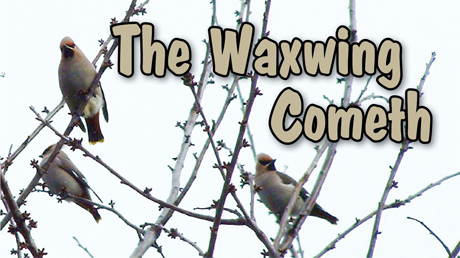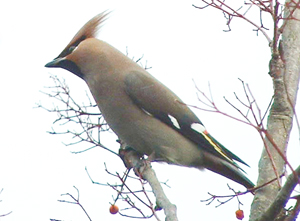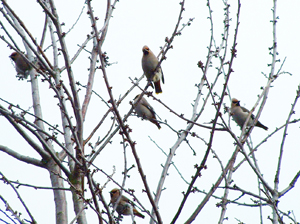Waxwing - Healthy Life Essex
Home » Articles » Outdoor Life » Wildlife » Birds » Waxwing

Britain must once again be set for invaders from the Scandinavian north, a millennia on from the Viking landings to our peaceful shores! Well, not just Scandinavia, but also Siberia. And neither must we brace ourselves for a scrap with the good folk from across the North Sea. We need be prepared for nothing more ominous in fact, than the chance of some added excitement to our winter bird life.
 The invasion, or to put it more precisely, the ‘irruption’ in question is that of the waxwing (Bombycilla garrulus), one of the less familiar of British Birds and also one of the most attractive. They are compact, starling-sized birds, handsomely crested and chiefly a buff pink in colour, not dissimilar to that of the so very well-known jay. This though, is not the most striking aspect of their plumage. There are the red tips of the secondary wing feathers, which appear as a row of red ‘blobs’ half way along the wing, thought to resemble sealing wax from which the bird takes its name. Then there is the vivid flash of yellow on the tip of the tail, as if it has been dipped in paint, and also that to be seen on the wings, created by the coloured tips, this time of the primary wing feathers. White wing-bars on black wings, a slate-grey rump and crimson-flushed black face-mask and throat complete a picture of what is a very beautiful bird indeed.
The invasion, or to put it more precisely, the ‘irruption’ in question is that of the waxwing (Bombycilla garrulus), one of the less familiar of British Birds and also one of the most attractive. They are compact, starling-sized birds, handsomely crested and chiefly a buff pink in colour, not dissimilar to that of the so very well-known jay. This though, is not the most striking aspect of their plumage. There are the red tips of the secondary wing feathers, which appear as a row of red ‘blobs’ half way along the wing, thought to resemble sealing wax from which the bird takes its name. Then there is the vivid flash of yellow on the tip of the tail, as if it has been dipped in paint, and also that to be seen on the wings, created by the coloured tips, this time of the primary wing feathers. White wing-bars on black wings, a slate-grey rump and crimson-flushed black face-mask and throat complete a picture of what is a very beautiful bird indeed.
Each year the eastern coast of England and Scotland receives a scattering of waxwing, typically in very small numbers, usually, according to the Royal Society for the Protection of Birds, less than one hundred. Every so often however, irruptions occur, when high numbers of birds and a scarcity of food on their normal wintering grounds forces them to forage more widely, resulting in greatly increased numbers reaching the UK. It is looking like such an influx is on the cards for the winter of 2010/11.
When not roaming across Europe, the waxwing is a creature of the Taiga, the swathe of conifer forest that stretches through the high northern latitudes of Europe, Asia and North America. Here they seek out mature, moss-clad and lichen-slung mixed woodland, building a nest high up in the tops of pine trees. Fed on berries and insects, a brood of half a dozen-chicks is ready to fledge after just two weeks.
 Where to go to find such a beauty when they do come to us in number? As birds of the great sweep of the lonely northern forests, presumably a traipse across some winter-weary landscape, searching among the deepest hawthorn scrub or our most remote woodland enclaves would be a necessary sacrifice on our part. Or perhaps in a car park outside a supermarket, or along a busy dual carriageway in town. Indeed, these fruit-hungry winter wanderers are far more likely to be encountered on the suburban fringe than the wilder reaches of the countryside. The draw to the insalubrious surroundings of supermarket car parks and unlikely roadsides is very often the berries of planted ornamental rowan trees, for which the birds have something of a penchant. They are prodigious consumers of berries, able to consume nearly their own weight in little more than a couple of hours. It is during such times that they can be a most abiding presence, often tolerating a close approach, but always remaining wary.
Where to go to find such a beauty when they do come to us in number? As birds of the great sweep of the lonely northern forests, presumably a traipse across some winter-weary landscape, searching among the deepest hawthorn scrub or our most remote woodland enclaves would be a necessary sacrifice on our part. Or perhaps in a car park outside a supermarket, or along a busy dual carriageway in town. Indeed, these fruit-hungry winter wanderers are far more likely to be encountered on the suburban fringe than the wilder reaches of the countryside. The draw to the insalubrious surroundings of supermarket car parks and unlikely roadsides is very often the berries of planted ornamental rowan trees, for which the birds have something of a penchant. They are prodigious consumers of berries, able to consume nearly their own weight in little more than a couple of hours. It is during such times that they can be a most abiding presence, often tolerating a close approach, but always remaining wary.
They can leave a place as abruptly as they arrive, disappearing to continue their scouring of the countryside (and town of course) for food. The most recent sightings in November 2010 were from around the grounds of the Wellesley hospital in Southend. No doubt sightings will continue through the winter and throughout the county as they resume their wandering. In the past they have made a habit of frequenting the retail grounds around Tesco in Pitsea, at times in some number. It is undeniably surreal to find yourself standing in the middle of a roundabout within the midst of South East Essex’s urban sprawl watching a hundred or so waxwing, birds of the Arctic wilderness that have flown hundreds of miles from their breeding quarters, clambering adroitly the branches of berry-laden trees. It is a surreal but wonderful experience and a reminder, if required, of nature’s seemingly endless propensity for surprise.
Words and images © Ross Gardner 2010
References
Allen, I. et al (1996) ‘The Complete Book of British Birds‘. Basingstoke: The Automobile Association.
Hume, R. (1998) ‘The MacMillan Guide to Birds of Britain and Europe‘. St Helens: MacMillan.
Mullarney, K. et al (2001) ‘Collins Bird Guide‘. London: HarperCollins.
Invasion of waxwings suggests a cold winter – The Telegraph
